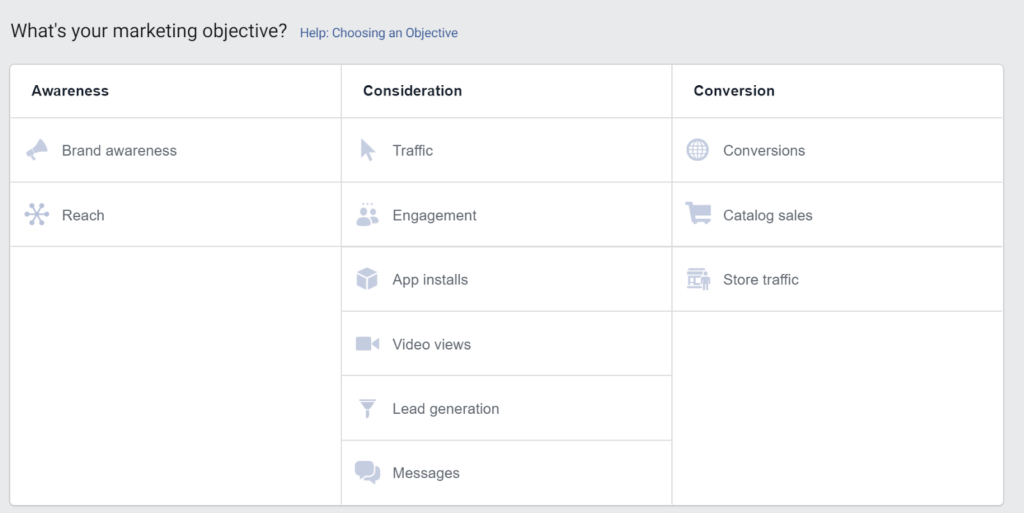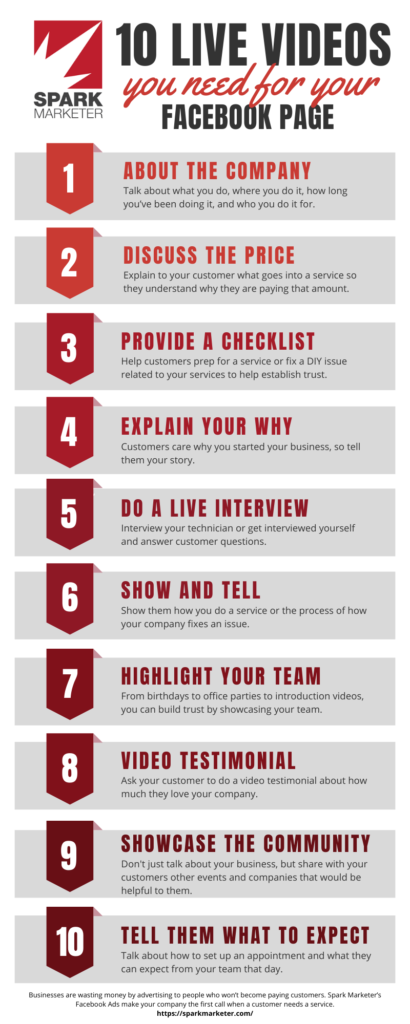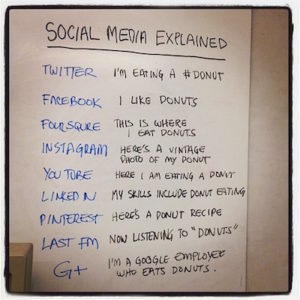
by Fred Brewer | Feb 28, 2020 | Client Tips, Facebook
Facebook and Instagram ads not performing as you expected? Not to worry, because we’re sharing our Facebook team’s top tips for troubleshooting and fixing poor ad performance.
If you want your ads performance to improve or you’ve noticed that your ads performance has changed drastically, these are the things you want to check:
- Are you using the right type of campaign for your goals?
- Is your targeting correct?
- Is there a problem with your budget?
- Has Facebook flagged any of your campaigns?
- Is your frequency too high?
- What’s your relevancy score?
- Has the competition ramped up?
#1 Are you using the right type of campaign for your goals?
If your ads aren’t doing well, the very first thing you need to look at is whether or not you’re using the right campaign. Does your objective match your goals?
Facebook has three different marketing objectives that each of their campaign types fall into: Awareness, Consideration, and Conversion.
Awareness includes brand awareness and reach campaigns.
This is the marketing objective you would choose if you were trying to get your company out in front of as many people as possible or in front of people that are best suited to what you’re offering.
Think: spreading the word.
Consideration includes traffic, engagement, video views, and any type of campaign that is designed to get the viewer to think about purchasing from you.
Conversion covers any type of campaign that’s designed to get those who see your ads to purchase from your brand, sign up for a webinar, or take whatever action it is that you consider your “end goal.”

Why does it matter if your campaign objective matches your goals?
Let’s say you want to drive store visits with your ads, but you’re using a traffic campaign. Well, you won’t see the end results you’re looking for.
Here’s why: A traffic campaign drives more traffic to your website, not your store.
In this case, you’d be better off with a conversion campaign that features ads with offers or incentives for visiting your store.
Make sense?
#2 Is your targeting correct?
The second thing you’d want to look at is your targeting.
When we talk about targeting with ads, we mean your audience. Who is in the audience you’re targeting with your ads? Is your audience large enough?
Facebook will show warnings like, “Your audience is too small,” or “Your audience is too broad,” and those things do affect performance.
So if you’re running the right type of campaign but you’re still not seeing the results you’d like to see, take a look at your audience and make sure you’re targeting the right people.
#3 Is there a problem with your budget?
The next thing to check is: is your budget feeding out?
While it’s not the only option, most people will be using a daily spend for their ads (for example: $5/day).
Now, let’s say you’re spending $20 a day and you’re thinking, “Wow, my campaigns are just not working.” If it’s budget-related you’re either:
- Not spending enough.
- Miscalculating your reach.
Let’s address spend first.
Let’s say your cost per result for a lead gen campaign is $25 and you’re spending a daily budget of $20…
Well, Facebook cannot get you a lead in one day with that budget. It needs two days worth of budget to get you a lead with that lead cost and that daily spend.
To see if this is the problem with your ads performance, you need to look at what your cost per result is and what you’re spending daily.
You might want to only spend $5/day, but if a lead in your industry costs more than that and you’re not willing to spend it, you’re wasting your money.
Facebook has to match industry standards and they can’t give you a lead for $5/day just because that’s what you want.
So if the average plumbing lead costs about $80, you need to be willing to spend at least $80/day or accept that you’re only going to get one lead every several days.
Now, let’s talk about your reach.
You may think that your reach is really wide and your budget will go a long way — but you could be wrong.
For example, you may think it’ll be $0.50 to $1.50 per lead, but Facebook may be saying something different, depending on the day.
So you need to look at the estimated daily reach. If that’s not lining up with what you’re getting in your results, then it’s time to switch campaigns, adjust your budget, and switch up some copy and headlines.
If it is matching, then Facebook is doing the best it can with what you’re giving it.
#4 Has Facebook flagged any of your campaigns?
Still not sure what’s affecting your ads performance? Then it’s time to look for any red flags (pun absolutely intended).
When you look at your dashboard, do you see any yellow or red triangles next to your ad sets, your ads, or your campaigns?
If you have a red triangle, you either need to fix that ad/ad set/campaign, or delete it.
Why delete? Even though that ad might be turned off, Facebook Ads Manager sees in there and can hold that against you in the long-run. So if you can’t fix it, get rid of it!
If you have a yellow triangle, read it and take action!
The nice thing about Facebook Ads Manager is that it tells you why it’s flagging something, so you can fix it.
And if you don’t understand what it’s saying, you can always go in and submit a request that says, “Hey, I don’t really know what this means,” or “Hey, I don’t agree with this.”
Flags can get overturned, but you can’t just ignore them.
#5 Is your frequency too high?
Let’s say your ads were running just fine for a couple of weeks or a month or two, and then all of the sudden, performance plummeted.
Chances are, your frequency is too high. Frequency means how many times a person has seen that specific ad in the time that it’s been running.
Why is too high of a frequency bad? It means people aren’t engaging with your ad anymore because they’ve seen it so many times.
What’s a good rule of thumb for frequency?
If your frequency is at or over four and your ads have started to decrease in results or increase in costs, it’s time to switch those ads out or update them.
You can keep the same campaign, you can even keep the same ad set, but you need to keep fresh ads coming in there.
#6 What’s your relevancy score?
If frequency is down and cost doesn’t seem too ridiculously high, but you’re just not seeing the results you hoped for, look at your relevancy scores.
Relevancy scores are broken down into three parts:
- Quality ranking — This is determined by the feedback on your ad in comparison to other ads going to the same audience. Are people liking it?
- Engagement ranking — This is determined by looking at how people are engaging with your ads. Are they getting a lot of likes, comments, clicks, shares, etc.?
- Conversion ranking — This is determined by looking at whether or not your ads are achieving the goals you’ve set for them. For example, if you’re running a traffic campaign, is this ad bringing more people to your site? If you’re running a conversion campaign, is the ad getting conversions and purchases?
If quality, engagement, and conversion rankings are low, and Facebook is saying your ads are in the bottom 25% of ads, chances are your ads just aren’t being shown, and people aren’t liking or engaging with the message you’re putting out there.
If this is the case, you need to completely overhaul your headlines, your copy, your videos, and your images, and get something out there that people really care about and want to engage with.
#7 Has the competition ramped up?
If you’re freaking out because your Facebook or Instagram ad costs just skyrocketed and you don’t know why, look at CPM. CPM = cost per thousand impressions.
If this number is high, it typically means that your competition has increased on Facebook or Instagram, and indicates that more people are targeting the same audience you’re targeting.
A good average CPM is between $5 and $15.
That said, during the holidays, you can expect a normal CPM to be $25+ because more people are typically vying for your audience’s attention during the holidays.
If it’s not holiday season and you have a really high CPM, that means you have a super competitive audience and it’s time to go back into your audience and see if you can adjust your targeting.
See if you can target people who are a good fit for your business in a different way, so that you can get those costs lower.
For example, you may use a lookalike audience instead of interest targeting, or you may focus on retargeting instead of cold audiences.
You’re still getting to the same people, you’re just going about it in a different, more cost-effective way.
Hope this post helps!

by Fred Brewer | Dec 30, 2019 | Client Tips, Facebook
You may think live video is something best left to influencers, musicians, and people who are supremely interesting. But no matter who you are or what you do, you should be leveraging live videos for your business.
Why?
- Live videos get a lot more engagement than pre-shot videos on Facebook and Instagram. The more engagement you get, the more Facebook and Instagram will want to show those videos to other people, and the more trust those videos will build.
- Live videos allow you to respond to questions in real time. People watching your videos can comment their questions and you can respond directly and get people to engage even more. Facebook live videos are the absolute best way to answer customer questions.
Ready for some ideas to help you get started with Facebook & Instagram live videos? Here’s our top 10…
#1 Talk about what you do, where you do it, how long you’ve been doing it, and who you do it for
The purpose of this type of video is to answer some of the common questions potential customers will have and want answered before they pick up the phone and call you.
What you do & where you do it:
Give those watching a good idea of what types of problems you solve and how you can help them. Let them know some of your top services and what areas you provide those services in.
How long you’ve been doing it:
Talk about how long you’ve been doing it and how your experience translates to value for your customers. The more you can talk about why you’re passionate about what you do, the more trust you’ll build with your potential customers.
Who you do it for:
Share what your dream customer looks like. Do you service apartments, homes, and commercial properties? Give details about who could and should hire you. If people see themselves in that persona, they’ll feel like you’re a good fit for them.
#2 Talk about price
Literally every business owner hates this one, but the ones that do it have found good success with it. What do we mean by success? Increased trust and less customer calls from people who don’t fit their demographic, can’t afford them, or are looking for a ‘cheap’ fix.
Now, do you need to go on live video and list every single service and every single price? No. What we recommend is that you talk about price for your top five most popular services or the top five services you’re wanting to do more of. Talk about:
- What is involved in that service
- Why it’s important
- An industry standard price
You do not need to tell them exactly what you charge for that service, but let your potential customers know what they might expect to pay when they call a company to schedule that service. That said, if you can go into specifics about what your company charges, DO IT.
We have a client who does share specifics. They say things like, “You know, we are higher priced than these other companies. Here’s why.” People are willing to pay a premium for a better service and a better experience — especially when the business is upfront about it.
#3 Give a safety list, to-do list, or some other step-by-step or numbered info
When you do a live video that quickly walks your customers through things like: “#1: do this. #2: do this,” people eat that up. Here are some example topics:
- How to find properly seasoned firewood
- How to properly store seasoned firewood
- How to unclog your drain — DIY
Anything that gives the customer value and makes something complicated or unclear a little bit simpler, do it. Sharing information and providing value for free builds trust with customers so that when they are in need of your services, you’re the one they think of.
#4 Talk about how you got started in the business
What did you do before you started the business, if you’re the business owner? Bring a little bit of your story into it and a little emotion into it, because, you guessed it: people love stories.
Where did you start? How did you get into the industry? It doesn’t have to be some magical story — just make it yours. Let it be raw. Let it be emotional. If it’s a story that’s worth crying over, cry. It’s okay.
Live videos are where you get to show the most emotion and be real with your customers.
#5 Interview one of your technicians or office staff about their favorite parts of their job or what their average day looks like
This is a fun, super short and simple live video that can really build trust and confidence in your company. It lets your customers see the faces of those working in your business, which is important because people don’t do business with businesses they like — they do business with people they like.
#6 Show them how something unique to your business works
People want to feel knowledgeable — like they know something their neighbors don’t know — and your live videos can help.
Most homeowners or customers don’t know about all the tools you use in your specific trade. So give them that information in case chimney sweeping or plumbing comes up during table talk.
Are you a plumber? Outside of a wrench and a plunger, many people have no idea what you use to get the job done. Plumbing relies on some pretty technologically advanced (and expensive) equipment. Equipment your customers don’t have sitting around in the garage. Let them know!
Are you a chimney sweep? People are imagining Dick Van Dyke with his filthy crew of singing and dancing sweeps. You’re not just showing up to the job with a broom. You’re not just using a Shop-Vac — it’s much more advanced than that right? Show them what you really use to get the job done and how you keep their homes from looking like London during the Industrial Revolution.
#7 Highlight how your team starts the day or a fun activity you guys like to do together
The goal of social media is to get people to know, like, and trust you. This is the like part of that. Show them that you have similar interests. Show them your morning routine or what everyone does when they get to the office.
Does everyone drink coffee together before heading out for the day? Great — highlight that. People love coffee!
If you get comments like, “Ew, you drink Dunkin Donuts coffee?” GREAT. Engagement is the goal, and your DD loving customers will like you even more because of that shared connection.
#8 Get a live video testimonial from a customer
We would love, love, love to see more of this. If you have a customer who’s been a customer for years and would feel comfortable providing a testimonial on camera, ask them to do it live! All you have to do is introduce them. For example:
“Hi, my name is Megan and I’m here with my client, Jessica. She just got Facebook Ad services and wanted to tell you a little bit about her experience so far.”
Then, just let your customer share.
These videos are easy and effective — you just have to make sure your customer’s comfortable sharing their experience. And here’s the best thing about these videos: If you tag the customer in the video, it’s not just going to be shared on your page — they’re going to want to share it with their family and friends on their own page as well. And their friends and family will say, “Oh, that’s my friend,” and want to share the video to their pages.
That’s going to broaden your post reach and increase your post engagement by so much. And funny enough, this is the #1 live video (after price) business owners don’t want to do.
#9 Interview someone prominent in the community that would have information that your audience might find helpful
This live video is designed to provide value, but doesn’t need to be tied directly to your business. For example, if I was a chimney sweep, I might interview a plumber. If I was a plumber, I might interview an HVAC company. If you know the mayor, reach out to the mayor if he’s well-liked. Ask to do a live video to go over some info that would be beneficial or helpful to your audience.
Let’s say you reach out to a local plumber and say,
“Hey, I’d like to do a quick interview with you. We’ll tag your business and you can share it on your page as well. What I’m hoping is that we can cover your top five plumbing tips for homeowners.”
Those tips will provide additional value to your customers and build trust. Plus, the plumber you interview will probably want to provide his or her audience with the same kind of value, and may ask you to do a video on their page (for example: providing your top five chimney maintenance tips).
It’s free, helpful content for your customers that makes both you and the company or individual you’re interviewing look more trustworthy.
#10 Tell them what to expect when they call to book with you
There are a lot of new homeowners out there who have no idea what to expect when they hire a plumber, chimney sweep, HVAC company, or other home service provider. So get rid of their uncertainty and help them call and book with confidence by enlightening them a little bit.
Tell them things like:
- What questions they may be asked on the phone and how they can figure out the answers to those questions ahead of time
- What to expect when you show up at their home to do the work
The best customer experiences are those when homeowners don’t have any questions because you’ve already answered them all. So, detail as much for them as you can and answer their questions before they have them.
P.S. Want to print a cheatsheet of ideas to jumpstart your brain when you’re planning your live videos? Just download and print the infographic below. 🙂

The killer formula for a good live video
Okay, so you’ve got some ideas for live video, but what about format? How the heck do you know how to start or wrap up your live video? Don’t worry, we won’t leave ya hanging. Here are the 7 components that pretty much every live video should have…
- Attention grabber – Grab you audience’s attention with a question or fact that will surprise them and draw them into the video.
- Intro – Next, introduce who you are and what you do. If you’re interviewing someone, introduce your guest here as well.
- State the problem – Get specific about the problem your customer is facing.
- Solve the problem – Tell them how your company can solve that problem.
- Show expertise – Explain your qualifications and how they make you an expert on this subject.
- Overcome objections – Help customers overcome objections with thorough explanations.
- Call to action – Close with an if/then call to action (CTA) that will urge them to contact you.
Now, grab your smartphone and go live!

by Fred Brewer | Oct 15, 2016 | Client Tips
Mick Jagger sings the above sentiment in the Rolling Stones’ song ‘Shattered,’ written back in the 1970’s. It is just as relevant now when teaching social media to others, not just the ‘how’ but the ‘why.’ (Once you grasp the ‘why,’ the ‘how’ gets a lot easier.)
What is a cocktail party but social gathering, with the goal to meet other people and get to know them better? In terms a business owner can easily understand, it’s networking. It’s connecting with people and entities with whom you’d like to do business.
Like a large cocktail party, social media’s multiple channels can be dauntingly vast and off-putting. What makes it worth staying and mingling are the aforementioned connections, as well as social media’s ability to help establish your business’s presence locally and on the internet. Yup, we said it – your internet presence, i.e. ranking on search engines. I see we have your attention.
With most social media channels your posts will get indexed by search engines, alerting them that you are active and relevant. If you are more relevant than your local competition, who do you think will rank higher on someone’s internet search for your services in your service area? This is good stuff.
But how does it all work? Do you HAVE to be on every social media channel out there? One does not have to be active on every channel. Presence on three to four social media networks is the norm. Find the ones with which you are most comfortable and dabble.
Here are 4 tips to help you get the most out of your social media efforts…
#1 Find Your Voice
Think about how you want your brand to be presented. Who is the best person to represent the voice of your company? It’s you or a trusted member of your staff. Can others do the job for you? Certainly you receive enough spam email and robo calls hawking these services, but it is a step removed. And though it can be crisp ,it is not as authentic as your own voice. Find your voice.
#2 Find Your Medium
Do you take video at your business? YouTube, Google Posts, and Facebook/Instagram stories are for you. Do you like taking photos on the job and around town?  Instagram, Facebook, Google Posts, and Pinterest are great opportunities to share. Don’t forget Twitter. You’ve got options!
Instagram, Facebook, Google Posts, and Pinterest are great opportunities to share. Don’t forget Twitter. You’ve got options!
Don’t think you have the time to make it work? A smart phone can record a photo and a moment for later posting, either sitting in the passenger seat heading towards the next job, at the office after work, or later after dinner at home. Both paid and free tools exist to help with scheduling so you can get work done ahead of time and remove some of the pressure.
#3 Find Your Flow
Presenting your latest offer or deal repeatedly on Facebook, Twitter, and Instagram is not ‘doing social media.’ It is a part – you get partial credit for that. For full credit, you also need to follow other accounts, share some of their posts, like some of their posts, and comment occasionally. It’s interacting. It’s being social. How do you enjoy listening to that one person at a party who talks incessantly about themselves? You likely find yourself looking for the door or hoping for a rescue text or phone call. Don’t make your customers feel that way.
#4 Find Your Sweet Spot
Sure it involves a little trial and error – after all, what works for one company may not work for another – but social media is a must. Figure out what works for your business and what engages your customers – find your sweet spot.
Social media for business is a little like a great chili recipe. There are dozens of viable and successful ways to do it right. The most important thing being: you are the one directing the kitchen.





 Instagram, Facebook, Google Posts, and Pinterest are great opportunities to share. Don’t forget Twitter. You’ve got options!
Instagram, Facebook, Google Posts, and Pinterest are great opportunities to share. Don’t forget Twitter. You’ve got options!